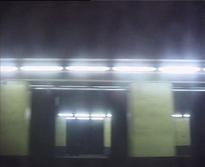INSTALLATION #3 - FROM THE SOUTH STATION TO THE NORTH STATION
Michel Lorand created a trio of installations at the three hubs on Brussels’ North-South rail link – at the ‘Martini Tower’ (#1, May 2000) located near the Gare du Nord, in the underground passage linking the Gare Centrale with the underground station of the same name (#2, October 2001), and in the station halls of the Gares du Nord and Midi, featuring the projection of a film of the route connecting the two (#3, autumn 2002). In these three urban projects, Lorand shows clearly that Brussels is a city that continues to wrestle stubbornly with its modernity. He chose locations that, in isolation, epitomise the modern metropolitan condition: places where high-rises, large infrastructure projects, mobility, crowds and a combination of functions and programmes crystallise. Brussels’ North-South axis, however, delineates an urban planning and architectural trajectory along which a fatally flawed megalomania was reined in by a cosiness every bit as questionable and embellishment that is no less deceitful. Project developers and politicians embraced a faded modernism stripped of any socially utopian aspirations, before giving way to a new generation of builders, who sought refuge in ludicrous historical pastiches. Under the motto ‘form follows finance’, echoes of the Manhattan project in the city’s Northern district have been allowed to blend seamlessly with imitation stepped gables at the ‘Carrefour de l’Europe’. Brussels’ North-South rail link functions in this respect as a magnifying glass that shows up the bankruptcy of both modernist urban planning and the post-modern patchwork. Such processes can, of course, be found in every city, yet they take on a specific meaning in Brussels, because this is a city that seems – reluctantly at times – to be the capital of several different political entities, leaving it embroiled in a permanent identity crisis. Installation #3 consists of a film projected in the station halls of both the Gare du Nord and the Gare du Midi in a specially constructed, room-sized film theatre. The film, which lasts about seven minutes, shows the route – partly above ground, partly underground – of Brussels’ North-South rail link, the plans for which were drawn up in the 19th century but which were not implemented until 1952. The theme of the passageway and of the shifting urban view to which both previous installations alluded is here presented literally. Michel Lorand skilfully integrates the train – the subject, appropriately enough, of the very first film and the requisite metaphor in any didactic explanation of the theory of relativity – into his characteristic visual idiom of movement, perceptual transitions and optical oscillation between transparency and reflection. Not only does the film evoke the city with its alienating, empty stations, it also transforms the train ride into a complex interaction of flickers and reflections between the camera lens, the countless windows of passing trains and the neon lamps attached to the pillars of the tunnel. Just as rails are installed to film ‘travelling shots’ and just as a filmstrip resembles a railway line, Lorand reduces a train journey recorded with a video camera to the interplay of optical stimuli and urban shifts. (Steven Jacobs)

- Format Betacam SP(Betacam SP)
- Color system PAL
- Color col.
- Year 2002
- Duration 00:07:11
-
Artists
-
EVENTS